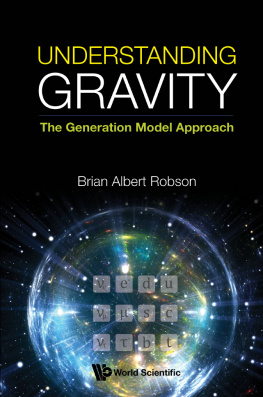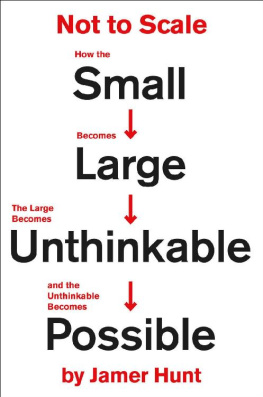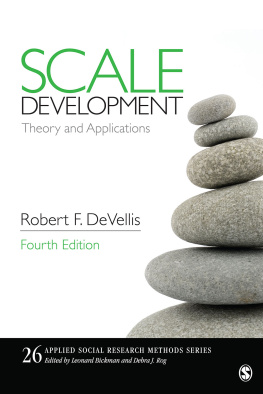
Scale Theory
Scale Theory
A Nondisciplinary Inquiry
Joshua DiCaglio

University of Minnesota Press
Minneapolis
London
The University of Minnesota Press gratefully acknowledges the financial assistance provided for the publication of this book by the Department of English at Texas A&M University.
Portions of chapters 8 and 11 are adapted from Scale Tricks and God Tricks, or The Power of Scale in Powers of Ten, in Configurations 28, no. 4 (Fall 2020): 45990; copyright 2020 Johns Hopkins University Press and Society for Literature, Science, and the Arts.
Copyright 2021 by the Regents of the University of Minnesota
All rights reserved. No part of this publication may be reproduced, stored in a retrieval system, or transmitted, in any form or by any means, electronic, mechanical, photocopying, recording, or otherwise, without the prior written permission of the publisher.
Published by the University of Minnesota Press
111 Third Avenue South, Suite 290
Minneapolis, MN 55401-2520
http://www.upress.umn.edu
ISBN 978-1-4529-6649-6 (ebook)
A Cataloging-in-Publication record for this book is available from the Library of Congress.
The University of Minnesota is an equal-opportunity educator and employer.
Contents
Learning to Scale
In the Atrium
On your way to the Hayden Planetarium in the New York Museum of Natural History, you may or may not notice an exhibit displayed in the atrium between the planetarium and a gift shop. This exhibit, titled Scales of the Universe, uses the sphere of the Hayden Planetarium to portray the relative size of the planets in the solar system. Along the walkway, a series of plaques show the major size scales of the universe, including a powers of 10 diagram pointing to the relative sizes of objects from atoms to galaxies.
You may pause on this view for a moment and find this range of sizes interesting. But, most likely, youll follow the crowd around to the planetarium entrance (or the gift shop), where the exciting science communication occurs. There, with incredible production value and, as of this writing, Neil deGrasse Tysons dramatic narration, youll learn about the far-flung objects of space and new, amazing discoveries about dark matter.
In this way, scale is often, in some sense, left in the atrium of science and human knowledge. We know that it is significant that we have discovered such magnitudes and this bewildering, nested nature of objects. But we get distracted by the main event, the reason we found these radically different scales to begin with: we want to know about these things we find at new scales, how they work, what they do, how they relate to each other. The production value there is much higherits where science feels like explanation, technologies find themselves intervening in helpful (and lucrative) ways, and medical advancements alleviate the human condition. We want to know about the vast or infinitesimal structure of the universe, but how long do we pause to consider the conditions for arriving at these different scales? We want to scale our businesses or intervene in the structures of matter, but rarely pause to consider what that reach into different scales implies and requires. We find ourselves sequencing, replicating, and even copyrighting genes, making statements about the possible toxicity of molecular components, and know that, somehow, the collective actions of Homo sapiens scratching, hacking, and fracking at the Earth are manifesting as ecological effects, but find ourselves struggling to describe how such scale domains work. We want to think globally and act locally but dont consider how we made that distinction in the first place.
Of course, plenty have highlighted scalethe Scales of the Universe exhibit exists alongside extensive scalar productions and descriptions. I point to this exhibit in the atrium merely to highlight how scale has been held as of secondary interest. We want to know how life works, how systems work, how information works, how galaxies form, how atoms get put together, how ecologies interactand only then, because these require scale, do we find ourselves commenting on scale. The aim of this book is to remain as carefully and patiently as possible in the atrium and examine the contours of scale itself.
The Centrality of Scale
Once we turn to scale, it appears both essential and mystifying. As the ecologist Simon A. Levin once argued, scale is the fundamental conceptual problem in ecology, if not in all of science. This simple claim grows in significance as this seemingly specialized concern recurs at the heart of apparently disparate inquiries. We notice that all science moves within and along different scales: whether probing the relationship between quantum motions and stellar phenomena, between DNA molecules and the formation of bodies, or between human actions and ecological effects, scientists are forced to navigate bewildering scalar forms as they reveal elaborate scalar objects, map entangled scalar relations, and somehow delineate the sizes and locations of their sites of study.
The nonscientist may recognize something of scale in the familiar philosophical and political questions about parts and wholes, in which, as Levin continues, dynamics at one level of organization can be understood as the collective behavior of aggregates. Science has brought into focus the question of parts and wholes according to discrete and empirically probed descriptive levels: how exactly do these atoms, cells, bodies, planets, solar systems, galaxies relate? All science must carefully and precisely specify the scales being considered. In doing so, science becomes inextricably entangled with this idea called scale.
Why? Scale is required for specifying what is being seen and studied. It is, as Levin notes, fundamentally about observation: When we observe the environment, we necessarily do so on only a limited range of scales; therefore, our perception of events provides us with only a low-dimensional slice of a high-dimensional cake. Whether selected by choice or by a limitation in the organism, this slice changes what is observed. As a scientist, Levin is interested in how these different scales affect scientific practice. However, he notes that this observational problem is not limited to those organisms known as scientists. Rather, all organisms face the same dilemma: for particular life history stages, the realized environmental variability will be a consequence of the scales of experience. This statement is monumental. What we are able to see, do, react to, develop, and interact with (this realized environmental variability) is not only related to scale but is a consequence of it. The scale of experience determines in some way what any organismwhat we ourselvesis able to see and do.
Yet, these Homo sapiens move beyond this scale of experience as sciences scalar descriptions saturate our ways of speaking and thinking and intervening. Levins primary example of scalar methods is trying to understand the relation between fine-scale phenomena of human activity and changes in climate. If the problem of scale is a problem for science, how can it not also be a problem for all of us as we try to understand our relation to these cells and ecosystems, atoms and galaxies? Levin thus opens space for a larger claim: scale is not only a fundamental aspect of all science but is a fundamental aspect of all inquiry. Because scale underlies observation, it is implicit within our ways of dividing, grouping, and relating together the various aspects of the world. When we speak about society, culture, language, evolution, humanity, objects, matter, economicswe are working with certain assumptions about scale. Thus, we need a broader acknowledgment of scales foundational and inescapable place in (re)defining our most basic concepts. As scales relationship to science indicates, scale is a particular conceptual tool that has its own parameters, constraints, and rules. This book aims to outline these parameters.
Next page












